We have given these Accountancy Class 12 Important Questions and Answers Chapter 10 Accounting Ratios to solve different types of questions in the exam. Go through these Class 12 Accountancy Chapter 10 Accounting Ratios Class 12 Important Questions and Answers Solutions & Previous Year Questions to score good marks in the board examination.
Accounting Ratios Important Questions Class 12 Accountancy Chapter 10
Question 1.
State how personal bias can get reflected in ratio analysis. (All India (C) 2011)
Answer:
In many situations, the accountant has to make the choice out of various alternatives available, e.g. choice in the method of depreciation (straight line or written down), choice in the method of inventory valuation (LIFO, FIFO or HIFO). Since the subjectivity is inherent in personal judgement, the financial statements are therefore not free from personal bias. As a result, ratio analysis cannot be said to be free from bias.
![]()
Question 2.
State any two limitations of ratio analysis. (All India (C) 2010)
Answer:
The two limitations of ratio analysis are
- Accounting ratios ignore qualitative factors.
- Affected by personal bias and ability of the analyst.
Question 3.
What is meant by accounting ratios? (Delhi (C) 2010)
Answer:
An accounting ratio is a mathematical expression of the relationship between two items or group of items shown in the financial statements.
Question 4.
State with reason whether repayment of long-term loan will result in increase, decrease or no change of debt equity ratio. (All India 2012)
Answer:
Debt-equity ratio will decrease as repayment of long-term loan will reduce the long- term debt but the shareholders’ funds will remain same.
Question 5.
A company had current assets ₹ 3,00,000 and current liabilities ₹ 1,40,000. Afterwards, it purchased goods worth ₹ 20,000 on credit. Calculate the current ratio after the purchase of goods. (All India 2019)
Answer:
New current assets = 3,00,000 + 20,000
New current liabilities = 1,40,000 + 20,000 = ₹ 1,60,000
Current Ratio = \(\frac { current assets }{ current liabilities }\)
= \(\frac { 320000 }{ 160000 }\) = 2 : 1
Question 6.
From the following information calculate interest coverage ratio. Net profit after interest and tax ₹ 1,20,000; Rate of income tax 40% ; 15% debentures ₹ 1,00,000; 12% mortgage loan ₹ 10,000. (All India2019)
Answer:
Rate of tax 40%
Profit after tax = 100 – 40 = 60% and according to question profit after tax is ₹ 1,20,000.
So, profit before tax = \(\frac { 120000 }{ 60% }\) = 2,00,000 60%
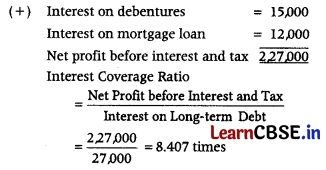
Question 7.
What is meant by ‘profitability ratios’? (All India 2016)
Answer:
Profitability ratios measure the profitability of a business. Profitability ratios help in assessing the . overall efficiency of the business. These ratios are calculated to analyse the earning capacity of the business which is the outcome of utilisation of resources employed in the business. Various profitability ratios commonly used to analyse the earning capacity of the business are gross profit ratio, net profit ratio, operating ratio, return on investment, operating profit ratio.
Question 8.
The current ratio of Y Ltd is 2 : 1. State with reason, which of the following transactions would (a) increase, (b) decrease or (c) not change the ratio
(i) Trade receivables included debtors of ₹ 40,000 which were received Company purchased furniture of ₹ 45,000. The vendor was paid by issue of equity shares of ₹ 10 each at par (Delhi 2014)
Answer:
(i) Not change the ratio Simultaneous increase and decrease by same amount in current assets will not effect the value of current assets or current liabilities, therefore, there is no effect on the current ratio.
(ii) Not Change the ratio Issue of shares for furniture purchased do not effect either current assets or current liabilities. Therefore, current ratio will not be effected.
Question 9.
The quick ratio of Z Ltd is 1 : 1 State with reason which of the following transactions would (a) increase, (b) decrease or (c) not change the ratio
(i) Included in the trade payables was a bills payable of ₹ 3,000 which was met on maturity.
(ii) Debentures of ₹ 50,000 were converted into equity shares. (Delhi 2014)
Answer:
(i) Not change the ratio Simultaneous decrease in both current assets and current liabilities will not effect the quick ratio.
(ii) Not change the ratio Debentures converted into shares do not effect either quick assets or current liabilities. Therefore, quick ratio will not be effected.
Question 10.
X Ltd has a current ratio of 3 : 1 and quick ratio of 2 : 1. If the excess of current assets over quick assets as represented by inventory is ₹ 40,000, calculate current assets and current liabilities. (All India 2012)
Answer:
Let the current liabilities = x

Therefore, quick or liquid assets = 2x
Liquid Assets = Current Assets – Inventory
2x = 3x – 40,000
2x – 3x = -40,000
-x = -40,000
x = 40,000
Current Liabilities = ₹ 40,000
Current Assets = 3 × ₹ 40,000 = ₹ 1,20,000
Question 11.
OM Ltd has a current ratio of 3.5 : 1 and quick ratio of 2 : 1. If the excess of current assets over quick assets as represented by inventory is ₹ 1,50,000, calculate current assets and current liabilities. Delhi 2012
Answer:
Solve as Q no. 7 on page 433.
Current Liabilities = ₹ 1,00,000
Current Assets = ₹ 3,50,000
Question 12.
On basis of the following information, calculate
(i) Debt equity ratio
(ii) Working capital turnover ratio. (Delhi 2011)
| Information | Amount |
| Revenue from operations | 60,00,000 |
| Cost of revenue operations | 45,00,000 |
| Other current assets | 11,00,000 |
| Current liabilities | 4,00,000 |
| Paid-up share capital | 6,00,000 |
| 6% debentures | 3,00,000 |
| 9% loan | 1,00,000 |
| Debenture redemption reserve | 2,00,000 |
| Closing inventory | 1,00,000 |
Answer:
(i) Debt equity ratio

Long-term Debts = 6% Debentures + 9% Loan
= 300000 +100000 = ₹ 400000
Shareholders Funds = Paid-up Share Capital + Debenture Redemption Reserve
= 600000 + 200000 = ₹ 800000
(ii) Working Capital Turnover Ratio

*Working Capital = Current Assets** – Current Liabilities***
= 12,00,000 – 4,00,000
= ₹ 8 00 POO
**Current Assets = Other Current Assets + Closing Inventory
= 1100000 + 1,00,000
= ₹ 12,00,000
***Current Liabilities = ₹ 4,00,000
![]()
Question 13.
The quick ratio of a company is 2 : 1. State giving reasons, (for any four) which of the following would improve, reduce or not change the ratio
(i) Purchase of machinery for cash
(ii) Purchase of goods on credit
(iii) Sale of furniture at cost
(iv) Sale of goods at a profit
(v) Cash received from debtors. (Delhi (C) 2011)
Answer:
(i) Purchase of Machinery for Cash:
Effect Reduce
Reason Purchase of machinery for cash will decrease the quick assets, but the current liabilities will remain unchanged.
(ii) Purchase of Goods on Credit:
Effect Reduce
Reason Purchase of goods on credit will increase the current liabilities, but the quick assets will remain unchanged.
(iii) Sale of Furniture at Cost:
Effect Improve
Reason Sale of furniture at cost will increase the quick assets, but the current liabilities will remain unchanged.
(iv) Sale of Goods at a Profit:
Effect Improve
Reason Sale of goods at a profit will increase the quick assets, but the current liabilities will remain unchanged.
(v) Cash Received from Debtors:
Effect No change
Reason Cash received from debtors will not change the quick assets because the quick assets are increased and decreased with the same amount, and the current liabilities remain unchanged.
Question 14.
The debt equity ratio of a company is 1:1 state giving reasons, (any four) which of the following would improve, reduce or not change the ratio
(i) Purchase of machinery for cash
(ii) Purchase of goods on credit
(iii) Sale of furniture at cost
(iv) Sale of goods at a profit
(v) Redemption of debentures at a premium (All India (C) 2011)
Answer:
(i) Purchase of Machinery for Cash:
Effect No change
Reason Neither the long-term debt nor the shareholders’ funds are affected by purchase of machinery for cash.
(ii) Purchase of Goods on Credit:
Effect No change
Reason Neither the long-term debt nor the shareholders’ funds are affected by purchase of goods on credit.
(iii) Sale of Furniture at Cost:
Effect No change
Reason Neither the long-term debt nor the shareholders’ funds are affected by sell of furniture at cost.
(iv) Sale of Goods at a Profit:
Effect Reduce
Reason Shareholders’ funds are increased by the amount of profit on sale of goods, but the long-term debts remain unchanged.
(v) Redemption of Debentures at a Premium:
Effect Reduce
Reason Redemption of debentures will reduce the long-term debts, but shareholders’ funds remain unchanged. Here,it is assumed that premium payable on redemption of debenture is written-off through existing securities premium reserve.
Question 15.
Assuming that the debt equity ratio is 2 : 1. State giving reasons whether this ratio would increase, decrease or remain unchanged in the following cases. (Any four)
(i) Purchase of fixed assets on a credit of two months
(ii) Purchase of fixed assets on long-term deferred payment basis
(iii) Issue of new shares for cash
(iv) Issue of bonus shares
(v) Sale of fixed assets at a loss of ₹ 3,000. (Delhi All India 2010)
Answer:
(i) Purchase of Fixed Assets on a Credit of Two Months
Effect No change
’Reason Neither the long-term debt nor the shareholders’ funds are affected by purchase of fixed assets on a credit of two months.
(ii) Purchase of Fixed Assets on a Long-term Deferred Payment Basis
Effect Increase
Reason The long-term debts are increased by the purchase of fixed assets on a long-term deferred payment basis, but the shareholders’ fund remains unchanged.
(iii) Issue of New Shares for Cash:
Effect Decrease
Reason Shareholders’ funds are increased by the issue of new shares for cash, but the long-term debts remain unchanged.
(iv) Issue of Bonus Shares:
Effect No change
Reason Shareholders’ funds increase and decrease by the same amount.
(v) Sale of Fixed Assets at a Loss of ₹ 3,000:
Effect Increase
Reason The shareholders’ funds will reduce by the amount of loss of 3,000, but the long-term debt remain unchanged.
Question 16.
From the following information, calculate any two of the following ratios
(i) Current ratio
(ii) Debt equity ratio
(iii) Inventory turnover ratio
Information:
Revenue from operations (Net sales) ₹ 5,00,000, opening inventory ₹ 7,000, closing inventory ₹ 4,000 more than the opening inventory, net purchase ₹ 1,00,000 less than revenue from operations, operating expenses ₹ 30,000, liquid assets ₹ 75,000, prepaid expenses ₹ 2,000, current liabilities ₹ 60,000, 9% debentures ₹ 3,00,000, long-term loan from bank ₹ 1,00,000, equity share capital ₹ 10,00,000 and 8% preference share capital ₹ 2,00,000. (Delhi 2010)
Answer:
(i) Current ratio = \(\frac { Current Assets }{ Current Liabilities }\)
= \(\frac { 88000 }{ 60000 }\) = 1.47 : 1
‘Current Assets = Liquid Assets + Closing Inventory** + Prepaid Expenses
= 75000 + 11000 + 2000
= ₹ 88000
Closing Inventory = Opening Inventory + 4,000
= 7000 + 4000 = ₹ 11000
![]()
‘Long-term Debts = 9% Debentures + Long-term Loan from Bank
= 3,00,000 +1,00000 = ₹ 400000
‘‘Shareholders’ Funds = Equity Share Capital + Preference Share Capital
= 1000000 + 200000 = ₹ 1200000

‘Cost of Revenue from Operations = Opening Inventory + Net Purchases – Closing Inventory
= 7000 + (500000 -100000) -11000 = ₹ 3,96000

Question 17.
From the following information, calculate any two of the following ratios
(i) Liquid ratio
(ii) Gross profit ratio
(iii) Debt equity ratio
Information:
Revenue from operations (Net sales) ₹ 4,00,000, opening inventory ₹ 10,000, closing inventory ₹ 3,000 less than the opening inventory, net purchase 80% of revenue from operations, direct expenses ₹ 20,000, current assets ₹ 1,00,000, prepaid expenses ₹ 3,000, current liabilities ₹ 60,000, 9% debentures ₹ 4,00,000, long-term loan from bank ₹ 1,50,000, equity share capital ₹ 8,00,000 and 8% preference share capital ₹ 3,00,000. (All India (c) 2010)
Answer:
![]()
Closing Inventory = Opening Inventory – 3,000 = 10000 – 3000 = ₹ 7000
![]()
Net Purchases = 80% of Revenue from Operations = 400000 × \(\frac { 80 }{ 100 }\) = ₹ 3,20000
Cost of Revenue from Operations = Opening Inventory + Net Purchases + Direct Expenses – Closing Inventory
= 10000 + 3,20000 + 20000 – 7000 = ₹ 3,43000
‘Gross Profit = Revenue from Operations – Cost of Revenue from Operations
= 400000 – 3,43000 = ₹ 57000
![]()
‘Long-term Debts = 9% Debentures + Long-term Loan from Bank
= 400000 + 1,50000 = ₹ 550000
“Shareholders’ Funds = Equity Share Capital + 8% Preference Share Capital
= 800000 + 300000 = ₹ 1100000
![]()
Question 18.
Quick ratio of a company is 1 : 1. State, with reason, whether the following transactions will increase, decrease or not change the ratio
(i) Paid insurance premium in advance ₹ 10,000.
(ii) Purchased goods on credit ₹ 8,000.
(iii) Issued fully paid equity shares of ₹ 1,00,000.
(iv) Issued 9% debentures of ₹ 5,00,000 to the vendor for machinery purchased. (All India 2019)
Am. (i) Decrease
As payment of insurance premium will decrease the quick assets.
(ii) Decrease
As purchase of goods on credit will increase the current liabilities.
(iii) Increase
As issue of equity shares will increase quick assets.
(iv) No change
As issue of debentures to vendor of machinery would have no impact on quick assets and current liabilities.
Question 19.
From the following information of Shiva Ltd, calculate total assets to debt ratio (All India 2019)
| Information | Amount |
| Equity Share Capital | 5,00,000 |
| 9% Preference Share Capital | 4,00,000 |
| Fixed Assets | 12,00,000 |
| Non-current Investments | 1,50,000 |
| Reserves and Surplus | 2,40,000 |
| Current Assets | 1,90,000 |
| Current Liabilities | 1,00,000 |
Answer:
Total Assets = Fixed Assets + Non-current Investments + Current Assets = 12,00,000 + 1,50,000 + 1,90,000 = ₹ 15,40,000
Now, Total Liabilities = Total Assets
“Equity Share Capital + 9% Preference Share Capital + Reserve and Surplus + Non-current Liabilities (Debt) + Current Liabilities = ₹ 15,40,000
5,00,000 + 4,00,000 + 2,40,000 + 1,00,000 + Non-current Liabilitiess = ₹ 15,40,000
Non-current Liabilities (Debt) = 15,40,000 -12,40,000 = ₹ 3,00,000
Now, Total Assets to Debt Ratio = \(\frac { Total Assets }{ Debt }\) = \(\frac { 1540000 }{ 300000 }\) = 5.133 : 1
Question 20.
(a) Calculate revenue from operations of BN Ltd. From the following information
| Current assets | ₹ 8,00,000 |
| Quick ratio is | 1.5 : 1 |
| Current ratio is | 2 : 1 |
| Inventory turnover ratio is | 6 times |
(b) The operating ratio of a company is 60%. State whether ‘Purchase of goods costing ₹ 20,000’ will increase, decrease or not change the operating ratio. Qalhi 2019
Answer:
(a) Current assets = ₹ 800000
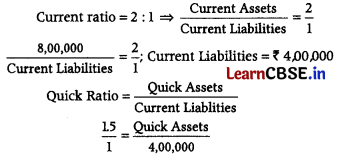
Quick Assets = ₹ 600,000
Inventory = Current Assets – Quick Assets
= 800000 – 600000 = ₹ 200000

Cost of Revenue from Operations = ₹ 12,00,000
Profit = 25% on cost = 12,00,000 × 25% = ₹ 3,00,000
Revenue from Operations = 12,00,000 + 3,00,000 = ₹ 15,00,000
(b) No Change
As purchase of goods will increase operating cost as well as cost of goods sold.
Question 21.
(a) Calculate ‘Total assets to debt ratio’ from the following information
| Information | Amount |
| Equity Share Capital | 4,00,000 |
| Long-term Borrowings | 1,80,000 |
| Surplus, i.e. Balance in Statement of Profit and Loss | 1,00,000 |
| General Reserve | 70,000 |
| Current Liabilities | 30,000 |
| Long-term Provisions | 1,20,000 |
(b) The debt equity ratio of a company is 1 : 2. State whether ‘Issue of bonus shares’ will increase, decrease or not change the debt equity ratio. (Delhi 2019)
Answer:
(a) Total Liabilities = Equity Share Capital + Long-term Borrowings + Surplus + General Reserve + Current Liabilities + Long-term Provisions
= 4,00,000 + 1,80,000 + 100000 + 70,000 + 30,000 + 1,20,000 = ₹ 900,000
Total Assets = Total Liabilities = ₹ 900000
Long-term Debt = Long-term Borrowings + Long-term Provisions
= 100000 + 1,20000 = ₹ 300000
Total Assets to Debt Ratio = \(\frac { Total Assets }{ Long term Debt }\) = \(\frac { 900000 }{ 300000 }\) = 3 : 1
(b) Decrease
As issue of bonus shares will increase the shareholders funds/equity.
Question 22.
The operating ratio of a company is 80%. State whether the following transactions will increase, decrease or not change the ratio
(i) Purchased goods on credit ₹ 20,000
(ii) Paid wages ₹ 5,000
(iii) Redeemed ₹ 8,000, 9% debentures
(iv) Sold goods ₹ 50,000 for cash. (All Indio 2019)
Answer:
(i) Purchased goods on credit ₹ 20,000
⇒ No change
As both purchase and closing stock will increase, so there will be no effect on cost of goods sold.
(ii) Paid wages ₹ 5,000
⇒ Increase
As wages paid will increase the operating cost.
(iii) Redeemed ₹ 8,000, 9% Debentures
⇒ No change
As redemption of debentures is a non-operating activity.
(iv) Sold goods ₹ 50,000 for cash
⇒ Decrease
As goods sold will increase the net sales.
Question 23.
From the following information obtained from the books of Kundan Ltd, calculate the inventory turnover ratio for the years 2015-16 and 2016-17.
| 2015-16 (₹) | 2016-17 (₹) | |
| Inventory on 31st March | 700000 | 1700000 |
| Revenue from Operations | 5000000 | 7500000 |
(Gross profit is 25% on cost of revenue from operations)
In the year 2015-16, inventory increased by ₹ 2,00,000. (CBSE 2018)
Answer:
For 2015-16
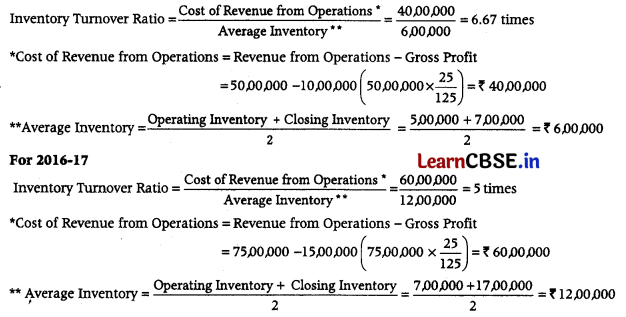
Question 24.
Y Ltd’s profits after insterest and tax was ₹ 1,00,000. Its current assets were ₹ 4,00,000 current liabilities ₹ 2,00,000; fixed assets ₹ 6,00,000 and 10% long-term debt ₹ 4,00,000. The rate of tax was 20%. Calculate ‘Return on Investment of Y Ltd. (Comportment 2018)
Answer:
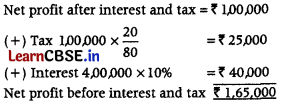
Working Capital = Current Assets – Current Liabilities
= 400000 – 200000 = ₹ 200000
Capital Employed = Fixed Assets + Working Capital
= 600000 + 200000
= ₹ 800000
Return on Investment

Question 25.
A company earn gross profit 25% on cost. For the year ended 31st March, 2017 its gross profit was ₹ 5,00,000; equity share capital of the company was ₹ 1,00,00,000; reserves and surplus ₹ 2,00,000; long-term loan ₹ 3,00,000 and non-current assets were ₹ 10,00,000.
Compute the ‘working capital turnover ratio of the company. (Comportment 2018)
Answer:
Gross Profit = 25% on cost
Gross profit ₹ 500000
∴ Revenue from Operation = \(\frac { 125 }{ 25 }\) × 500000
= ₹ 25,00,000
Working Capital = Equity Share Capital + Reserve and Surplus + Long-term Loan – Non-current Assets
= 1000000 + 200000 + 300000 -1000000 = ₹ 500000
Working Capital Turnover Ratio

Question 26.
The proprietary ratio of M Ltd is 0.80 : 1.
State with reasons whether the following transactions will increase, decrease or not change the proprietary ratio
(i) Obtained a loan from bank ₹ 2,00,000 payable after five years.
(ii) Purchased machinery for cash ₹ 75,000
(iii) Redeemed 5% redeemable preference shares ₹ 1,00,000.
(iv) Issued equity shares to the vendors of machinery purchased for ₹ 4,00,000. (All India 2017)
Answer:
(i) Decrease Loan obtained from bank will increase the total assets but the shareholders’ funds will remain the same, so proprietary ratio will decrease.
(ii) No change Machinery purchased for cash will increase and simultaneously decrease the total assets therefore proprietary ratio will remain unchanged.
(iii) Decrease Redemption of preference shares will decrease total assets and shareholders’ funds simultaneously, so proprietary ratio will decrease.
(iv) Increase Machinery purchased by issue of equity shares will increase total assets and shareholders’ funds simultaneously, so proprietary ratio will increase.
![]()
Question 27.
The quick ratio of a company is 0.8 : 1. State with reason whether the following transactions will increase, decrease or not change the quick ratio
(i) Purchase of loose tools ₹ 2,000.
(ii) Insurance premium paid in advance ₹ 500.
(iii) Sale of goods on credit ₹ 3,000.
(iv) Honoured a bills payable ₹ 5,000 on maturity. (Delhi 2017)
Answer:
(i) Decrease Purchasing loose tools will decrease the current assets but the current liabilities will remain unaffected, so quick ratio will decrease.
(ii) Decrease Insurance premium paid in advance will decrease the current assets but the current liabilities will remain unaffected, so quick ratio will decrease.
(iii) Increase Goods sold on credit will increase the quick ratio as current liabilities will remain unchanged and quick assets will increase, so quick ratio will increase.
(iv) Decrease Bills payable honoured on maturity will decrease the quick assets and current liabilities simultaneously, so quick ratio will decrease.
Question 28.
(i) What is meant by ‘activity ratios’?
(ii) From the following information calculate inventory turnover ratio, revenue from operations ₹ 16,00,000, average inventory ₹ 2,20,000, gross loss ratio 5%. (All India 2016)
Answer:
(i) Activity ratios show how efficiently a company is using its assets to generate sales. These ratios express the number of times assets employed or for that matter, any constituents of assets, is turned into sales during an accounting period. These ratios are also known as turnover ratios or performance ratios. These ratios are calculated on the basis of sales or cost of sales. The various activity ratios are inventory turnover ratios, trade receivables or debtors turnover ratio, trade payables or creditors turnover ratio, working capital turnover ratio.
(ii) Inventory Turnover Ratio
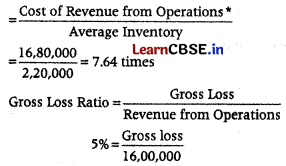
⇒ Gross Loss = 5% of 16,00,000 = ₹ 80,000
Cost of Revenue from Operations = Revenue from Operations + Gross Loss
= 16,00,000 + 80,000 = ₹ 16,80,000
Question 29.
(i) What is meant by ‘solvency of business?
(ii) From the following details obtained from the financial statements of Jeev Ltd, calculate interest coverage ratio Net profit after tax ₹ 1,20,000 12% long-term debt ₹ 20,00,000 Tax rate 40% (Delhi 2016)
Answer:
(i) Solvency of a business means the ability of business to pay off its long-term liabilities. Solvency ratios such as debt equity ratio, total ‘assets to debt ratio, interest coverage ratio etc are some of the important solvency ratios that help the investors to know about the credibility of business and accordingly take rational investment decisions. Better the solvency position of the business, the better the market standing of such firms.
(ii) Interest Coverage Ratio

Calculation of net profit before interest and tax Net profit after tax = 1,20,000; Tax = 40%
If profit after tax is 60, profit before tax is 100 and if profit after tax is ₹ 1,20300
Profit before tax would be
= \(\frac { 100 }{ 60 }\) × 1,20300 = ₹ 2,00,000
Interest on long-term debt
= 2,00,000 × 12% = ₹ 2,40,000
Therefore, Profit before interest and tax = 2,00,000 + 2,40,000 = ₹ 4,40,000
Question 30.
(i) What is meant by ‘profitability of business’?
(ii) From the following information, calculate operating profit ratio.
Opening stock ₹ 10,000, purchases ₹ 1,20,000, revenue from operations ₹ 4,00,000, purchase returns ₹ 5,000, returns from revenue from operations ₹ 15,000, selling expenses ₹ 70,000, administrative expenses ₹ 40,000, closing stock ₹ 60,000. (Delhi 2016)
Answer:
(i) Profitability is the basic objective of every business. Profitability is the measure of efficiency and success of the business. It is related to the income of the business, i.e. how much a concern is earning in relation to the capital invested by it. The various ratios which helps to measure the profitability of a business are gross profit ratio, net profit ratio, operating ratio etc. All these ratios are used to assess a business ability to generate earnings as compared to its expenses and other relevant cost during a specific period of time.
(ii) Operating Profit Ratio

‘Operating Profit = Revenue from Operations** – Cost of Revenue from Operations (Opening stock + Purchases – Closing stock) – Selling Expenses – Administrative Expenses
= 3,85,000 – [10800 +1,15,000 (1,20000 – 5000) – 60000] – 70,000 – 40000
= 385000 – 65000 – 70000 – 40000 = ₹ 2,10,000
“Revenue from Operations = Revenue from Operations – Returns from Revenue from Operations
= 400000 -15000 = ₹ 385000
Question 31.
(i) What is meant by “liquidity of business’?
(ii) From the following information calculate operating ratio
Revenue from operations 7 6,80,000, rate of gross profit on cost 25%, selling expenses ₹ 1,44,000, administrative expenses ₹ 73,000. (Delhi 2016)
Answer:
(i) Liquidity of business refers to the ability of the firm to meet its short-term obligations. Its the ability of an organisation to meet its current financial obligations. Liquidity ratios measure the ability of a company to meet its short-term debt obligations. The various liquidity ratios used for this purpose are current ratio and acid test ratio/quick ratio.
![]()
Operating Cost = Cost of Goods Sold + Operating Expenses
= 5,44000 + 1,44000 + 73000 = ₹ 781000
Gross profit = \(\frac { 1 }{ 4 }\) on cost Or \(\frac { 1 }{ 5 }\) on sales = \(\frac { 1 }{ 5 }\) × 680000 = ₹ 136000
Let cost of goods sold be = x ⇒ 136000 = \(\frac { 1 }{ 4 }\) × x ⇒ x = ₹ 5,44,000
NOTE: Operating expenses include selling and administrative expenses.
Question 32.
(i) From the following, calculate ‘Trade receivables turnover ratio”.
Total revenue from operations for the year – ₹ 8,40,000
Cash revenue from operations – 40% of credit revenue from operations
Closing trade receivables – ₹ 2,00,000
Excess of closing trade receivables over opening trade receivables ₹ 80,000
(ii) From the following information calculate ‘Interest coverage ratio’
Profit after interest and tax – ₹ 4,97,000
Rate of income tax – 30%
12% debentures – ₹ 6,00,000 (All India (C) 2016)
Answer:
![]()
Let, credit revenue from operations be x
Cash revenue from operations be x × 40% = 0.4x
Total Revenue from Operations = Cash Revenue from Operations + Credit Revenue from Operations
8,40,0 = 0.4x + x
8,40,000 = 14x
‘Credit revenue from operations ⇒ x ⇒ 6,00,000
Average Trade Receivables

Opening trade receivables
= 200000 – 80,000 = ₹ 1,20,000
(ii) Interest Coverage Ratio
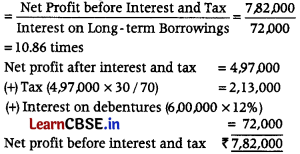
Question 33.
From the given information calculate the following
(i) Cost of revenue from operations
(ii) Opening and closing inventory
(iii) Quick assets
(iv) Current assets
Information Inventory turnover ratio 6 times, inventory at the end is ₹ 6,000 more than the inventory in the beginning, revenue from operations (all credits) ₹ 2,40,000, Gross profit 25% on cost, current liabilities ₹ 80,000, quick ratio 080 : 1. (Delhi (C) 2016)
Answer:
(i) Let cost be 100
Gross profit be = 25
Revenue from operations = 100 + 25 = 125
Revenue from operations (all credits) = 2,40,000
∴ Cost of revenue from operations
= 2,40,000 × \(\frac { 100 }{ 125 }\)
Cost of revenue from operations = ₹ 1,92,000
(ii) Let opening inventory be = x
Closing inventory be = x + 6000
Average Inventory
= \(\frac{x+x+6000}{2}=\frac{2 x+6,000}{2}\) = x + 3000
Inventory Turnover Ratio
Cost of Revenue from Operations

6x + 18,000 = 1,92,000
6x = 1,92,000 – 18,000
x = \(\frac { 174000 }{ 6 }\) = 29,000
‘Opening inventory ⇒ x ⇒ 29,000 = x + 6,000
Closing inventory = 29,000 + 6,000 = ₹ 35,000

Quick Assets = ₹ 64,000
(iv) Current Assets = Quick Assets + Inventory
= 64,000 + 35,000
Current Assets = ₹ 99,000
Question 34.
The current ratio of a company is 2.1 : 1.2. State with reasons which of the following transactions will increase, decrease or not change the ratio
(i) Redeemed 9% debentures of ₹ 1,00,000 at a premium of 10%.
(ii) Received from debtors ₹ 17,000.
(iii) Issued ₹ 2,00,000 equity shares to the vendors of machinery.
(iv) Accepted bills of exchange drawn by the creditors ₹ 7,000. (All India 2015)
Answer:
(i) Decrease Current assets will decrease because of outflow of cash but current liabilities will remain unchanged therefore current ratio will decrease.
(ii) Not change the ratio Simultaneous increase and decrease in the value of current assets i.e. cash and debtors by the same amount will not effect the ratio.
(iii) Not change the ratio Issue of shares for purchase of machinery do not effect either current assets or current liabilities, therefore current ratio will not be effected.
(iv) Not change the ratio In this case one current liability (i.e. creditors) is getting converted into another current liability (i.e. bills payable), therefore current ratio will not be effected.
![]()
Question 35.
From the following information related to Naveen Ltd, calculate (i) Return on investment (ii) Total assets to debt ratio. Information Fixed assets ₹ 75,00,000; current assets ₹ 40,00,000; current liabilities ₹ 27,00,000; 12% debentures ₹ 80,00,000 and net profit before interest, tax and dividend ₹ 14,50,000. (Delhi 2015)
Answer:
(i) Return on Investment
Net Profit before Interest,

Capital Employed = Fixed Assets + Currents Assets – Current Liabilities
= 75,00,000 + 40,00,000 – 27,00,000 = ₹ 88,00,000
(ii) Total Assets to Debt Ratio = \(\frac { Total Assets }{ Debt }\) = \(\frac { 1,15,00,000 }{ 80,00,000 }\) = 1.44 : 1
*Total Assets = Fixed Assets + Current Assets = 7500000 + 4000000 = ₹ 1,15,00,000
Question 36.
The current ratio of a company is 2.5 : 1.5. State with reasons which of the following transactions will increase, decrease or not change the ratio
(i) Discounted a bills receivable of ₹ 10,000 from bank. Bank charged discount of ₹ 200.
(ii) A bill receivable ₹ 8,000 discounted with bank was dishonoured.
(iii) Cash deposited into bank 7,000.
(iv) Paid cash ₹ 5,000 to the creditors. (Foreign 2016)
Answer:
| Effect | Explanation |
| (i) Decrease | Discounting a bills receivable from bank reduces asset by ₹ 10,000 (bills receivable) and increases asset by ₹ 9,800 (bank balance). |
| (ii) No change | Dishonour of discounted bills receivable results in increase in asset (debtors) and decrease in asset (bank) with the same amount. |
| (iii) No change | Increase in one current asset (bank) with a simultaneous decrease in other current asset (cash) with the same amount leaves current ratio unaffected. |
| (iv) Increase | Payment of current liabilities (creditors) will improve the current ratio from 1.67 (2.5 : 1.5) to 2 (2 : 1). |
Question 37.
From the following information, calculate total assets to debt ratio
| Information | Amt (₹) |
| Capital Employed | 25,00,000 |
| Investments | 2,10,000 |
| Land | 8,50,000 |
| Trade Receivables | 2,75,000 |
| Cash and Cash Equivalents | 1,50,000 |
| Equity Share Capital | 14,30,000 |
| 8% Debentures | 4,00,000 |
| Capital Reserve | 2,75,000 |
| Surplus, i.e. Balance in Statement of Profit and Loss | 1,50,000 |
Answer:
Total Assets to Debt Ratio = \(\frac{\text { Total Assets }}{\text { Debt }}=\frac{1485,000}{6,45,000}\) = 2.30 : 1
Total Assets = Investments + Land + Trade Receivables + Cash and Cash Equivalent
= 2,10000 + 8,50,000 + 2,75,000 + 1,50,000 = ₹ 14,85,000
Debt = Capital Employed – (Equity share capital + Reserves + Surplus)
= 25,00,000 – 18,55,000 (1430,000 + 2,75000 + 130000)
= ₹ 6,45,000
Question 38.
With the help of the following information, calculate return on investment. Net profit after interest and tax ₹ 6,00,000; 10% debentures ₹ 10,00,000; tax @ 40%; capital employed ₹ 80,00,000. (Delhi (C) 2015)
Answer:
Return on Investment
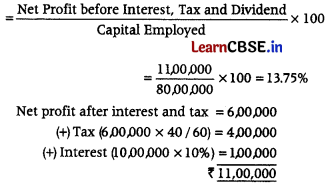
Question 39.
From the following calculate the ‘gross profit ratio’ and ‘working capital turnover ratio’ (Delhi (C) 2014)
| Information | Amt (₹) |
| Revenue from Operations | 30,00,000 |
| Cost of Revenue from Operations | 20,00,000 |
| Current Assets | 6,00,000 |
| Current Liabilities | 2,00,000 |
| Paid-up Share Capital | 5,00,000 |
Answer:
(i) Gross Profit Ratio

*Gross Profit = Revenue from Operations – Cost of Revenue from Operations
= 3000000 – 2000000 = ₹ 1000000
(ii) Working Capital Turnover Ratio

‘Working Capital = Current Assets – Current Liabilities
= 600000 – 200000 = ₹ 400000
Question 40.
(i) From the following information, compute ‘debt equity ratio’
| Items | Amt (₹) |
| Long-term Borrowings | 2,00,000 |
| Long-term Provisions | 1,00,000 |
| Current Liabilities | 50,000 |
| Non-current Assets | 3,60,000 |
| Current Assets | 90,000 |
(ii) The current ratio of X Ltd is 2 : 1.
State with reason which of the following transaction would increase, decrease or not change the ratio
(a) Included in the trade payables was a bills payable of ₹ 9,000 which was met on maturity.
(b) Company issued 1,00,000 equity shares of ₹ 10 each to the vendors of machinery purchased. (Delhi 2014)
Answer:
(i) Debt Equity Ratio

‘Long-term Debt = Long-term Borrowings + Long-term Provisions
= 200000 +100000 = ₹ 300000
“Shareholders’ Funds = Total Assets – Total Liabilities
= 4,50,000 – 3,50,000 = ₹ 1,00,000
Total Assets = Non-current Assets + Current Assets
= 300000 + 90000 = ₹4,50,000
Total Liabilities = Long-term Borrowings + Long-term Provisions + Current Liabilities
= 200000 +100000 + 50000 = ₹ 300000
(ii) (a) Increase in the ratio Simultaneous decrease in both current assets and current liabilities, i.e. cash and trade payable will increase the current ratio.
(b) No change in the ratio Issue of shares for machinery purchased do not affect either current assets or current liabilities, therefore, the current ratio will not be affected.
![]()
Question 41.
(i) The quick ratio of a company is 1.5 : 1. State with reason which of the following transactions would increase, decrease or not change the ratio
(a) Paid rent ₹ 3,000 in advance.
(b) Trade receivables included a debtor Shri Ashok who paid his entire amount due ₹ 9,700.
(ii) From the following information compute ‘proprietary ratio’ (All India 2014)
| Information | Amt (₹) |
| Long-term Borrowings | 2,00,000 |
| Long-term Provisions | 1,00,000 |
| Current Lliabilities | 50,000 |
| Non-current Assets | 3,60,000 |
| Current Assets | 90,000 |
Answer:
(i) (a) Not change the ratio:
Reason As there is a simultaneous increase and decrease in current assets by the same amount, i.e. prepaid expenses and cash, therefore it will not affect the value of current assets.
(b) Not change the ratio:
Reason As there is a simultaneous increase and decrease in current assets by the same amount, i.e. cash and trade receivables, therefore it will not affect the value of current assets.
(ii) Proprietary Ratio:
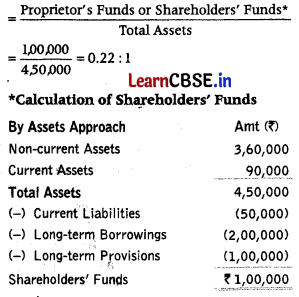
Question 42.
From the following calculate
(i) Operating profit ratio
(ii) Working capital turnover ratio. (All India (C) 2014)
| Information | Amt (₹) |
| Revenue from Operations | 2,00,000 |
| Gross Profit | 75,000 |
| Office Expenses | 15,000 |
| Selling Expenses | 26,000 |
| Interest on Debentures | 5,000 |
| Accidental Losses | 12,000 |
| Income from Rent | 2,500 |
| Commission Received | 2,000 |
| Current Assets | 60,000 |
| Current Liabilities | 10,000 |
Answer:
(i) Operating Profit Ratio

Operating Profit = Gross Profit – Other Operating Expenses + Other Operating Incomes
= 75,000 – 41,000 + 2,000
= ₹ 36,000
Other Operating Expenses = Office Expenses + Selling Expenses
= 15,000 +26,000
= ₹ 41,000
Other Operating Incomes = Commission
Received
= ₹ 2,000
(ii) Working Capital Turnover Ratio

‘Working Capital = Current Assets – Current Liabilities
= 60,000 – 10,000 = ₹ 50,000
Question 43.
From the following, calculate
(a) Current ratio; and (b) Working capital turnover ratio
| Particulars | Amt (₹) |
| Revenue from Operations | 1,50,000 |
| Total Assets | 1,00,000 |
| Shareholders’ Funds | 60,000 |
| Non-current Liabilities | 20,000 |
| Non-current Assets | 50,000 |
Answer:
![]()
Total Assets = Current Assets + Non-current Assets
1,00,000 = Current Assets + 50,000
Current Assets = 100,000 – 50000 = ₹ 50000
Current liabilities = Total Assets – Shareholders Funds – Non-current Liabilities
= 100000 – 60000 – 20000 = ₹ 20000
![]()
Working Capital = Current Assets – Current Liabilities = 50000 – 20000 = ₹ 30,000
Question 44.
(i) Compute ‘debtors turnover ratio’ from the following information
Revenue from operations (Total sales) ₹ 5,20,000, cash revenue from operations 60% of the credit revenue from operations, closing debtors ₹ 80,000, opening debtors are 3/4th of closing debtors.
(ii) Current liabilities of a company are ₹ 1,60,000. Its liquid ratio is 1.5 : 1 and current ratio is 2.5 : 1. Calculate quick assets and current assets. (All India 2013)
Answer:
![]()
Let Credit revenue from operations be y
Cash revenue from operations = 60% of credit revenue from operations Revenue from Operations = Cash Revenue from Operations + Credit Revenue from Operations
5,20,000 = 60% of y + y
5,20,000 = 0.6y + y
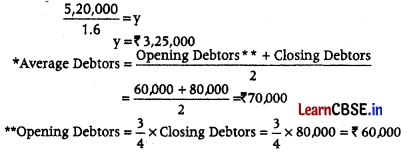
![]()
Quick Assets = 1.5 × 1,60,000 = 2,40,000
![]()
Current Assets = 1,60,000 × 2.5 = ₹ 4,00,000
Question 45.
(i) Compute ‘working capital turnover ratio’ from the following information
Cash revenue from operations ₹ 1,30,000, credit revenue from operations ₹ 3,80,000, returns from revenue from operations ₹ 10,000, liquid assets ₹ 1,40,000, current liabilities ₹ 1,05,000 and inventory ₹ 90,000.
(ii) Calculate ‘debt equity ratio’ from the following information
Total assets ₹ 3,50,000, total debt ₹ 2,50,000 and current liabilities ₹ 80,000. (Delhi 2013)
Answer:
![]()
Revenue from Operations = Cash Revenue from Operations + Credit Revenue from Operations – Returns from Revenue from Operations
= 130,000 + 3,80,000 – 10,000
= ₹ 5,00,000
Current Assets = Liquid Assets + Inventory = 1,40,000 + 90,000 = ₹ 230,000
Working Capital = Current Assets – Current Liabilities = 2,30,000 – 1,05,000 = ₹ 1,25,000
![]()
Long-term Debt = Total Debts – Current Liabilities
= 2,50,000 – 80,000
= ₹ 1,70,000
Equity or Shareholders’ Funds = Total Assets – Total Debt
= 3,50,000 – 2,50,000
= ₹ 1,00,000
![]()
Question 46.
From the following information, calculate any two of the following ratios
(i) Debt equity ratio
(ii) Working capital turnover ratio
(iii) Return on investment
Information Equity share capital ₹ 10,00,000, general reserve ₹ 1,00,000, balance of statement of profit and loss after interest and tax ₹ 3,00,000, 12% debentures ₹ 4,00,000, creditors ₹ 3,00,000, land and buildings ₹ 13,00,000, furniture ₹ 3,00,000, debtors ₹ 2,90,000, cash ₹ 1,10,000.
Revenue from operations, i.e. sales for the year ended 31st March, 2011 was ₹ 30,00,000. Tax paid is 50%. (All India 2012: Modified)
Answer:
![]()
Long-term debts = 12% debentures = 4,00,000
Shareholders’ Funds = Equity Share Capital + General Reserve + Balance of Statement of Profit and Loss
= 10,00,000 +1,00,000 + 3,00,000 = ₹ 14,00,000
![]()
Working Capital = Current Assets – Current Liabilities = 4,00,000 – 3,00,000 = ₹ 1,00,000
Current Assets = Cash + Debtors = 1,10,000 + 2,90,000 = ₹ 4,00,000
Current Liabilities = Creditors = ₹ 3,00,000

Profit before Interest and Tax = 6,00,000 + 48,000 (Interest on debentures) = ₹ 6,48,000
Capital Employed = Equity Share Capital + General Reserve + Balance in Statement of Profit and Loss + 12% Debentures
= 10,00,000 + 1,00,000 + 3,00,000 + 4,00,000
= ₹ 18,00,000
Question 47.
From the following information, calculate any two of the following ratios
(i) Debt equity ratio
(ii) Working capital turnover ratio
(iii) Return on investment
Information Equity share capital ₹ 50,000; general reserve 15,000; statement of profit and loss after tax and interest ₹ 15,000; 9% debenture ₹ 20,000; creditors ₹ 15,000; land and building ₹ 65,000; equipments ₹ 15,000; debtors ₹ 14,500 and cash ₹ 5,500; revenue from operations for the year ended 31st March, 2011 was ₹ 50,000. Tax rate 50%. (Delhi 2012 (Modified))
Answer:
Solve as Q no. 43 as page 448 and 449.
Debt Equity Ratio = 0.286 : 1 Working Capital Turnover Ratio = 30 times; Return on Investment = 35.33%
Question 48.
Cross-sectional analysis is related
(a) to take a correct action
(b) to compare firm’s present ratio with past
(c) to compare of a firm ratio with other
(d) None of the above
Answer:
(c) to compare of a firm ratio with other
Question 49.
Current ratio is

Answer:
(b)
Question 50.
Working capital is the
(a) difference between current assets and current liabilities
(b) difference between current assets and quick liabilities
(c) capital and liabilities difference
(d) cash and bank difference
Answer:
(a) difference between current assets and current liabilities
![]()
Question 51.
From the following, calculate current assets?
Cash balance – ₹ 5,000
Trade payable – ₹ 40,000
Inventory – ₹ 50,000
Trade receivable – ₹ 65,000
Prepaid expenses – ₹ 10,000
Creditors – ₹ 30,000
(a) ₹ 1,25,000
(b) ₹ 1,30,000
(c) ₹ 1,60,000
(d) ₹ 1,20,000
Answer:
(b) ₹ 1,30,000
Question 52.
If inventory is ₹ 1,00,000, current assets ₹ 8,00,000 and current liabilities ₹ 4,00,000, then what will be the liquid ratio?
(a) 1.75 : 1
(b) 2 : 1
(c) 2 : 3
(d) 3 : 1
Answer:
(a) 1.75 : 1
Question 53.
Which of the following transaction will improve the quick ratio?
(a) Purchase of inventory for cash
(b) Cash collected from debtors
(c) Sale of goods (costing 10,000 for ₹ 50,000)
(d) None of the above
Answer:
(c) Sale of goods (costing 10,000 for ₹ 50,000)
Question 54.
A firm has current ratio of 4 : 1 and quick ratio of 2.5 : 1. Assuming inventories are ₹ 15,000, find out total current assets?
(a) ₹ 10,000
(b) ₹ 25,000
(c) ₹ 40,000
(d) ₹ 15,000
Answer:
(c) ₹ 40,000
Question 55.
Ideal debt ratio is
(a) 1 : 2
(b) 2 : 2
(c) 3 : 2
(d) 2 : 1
Answer:
(d) 2 : 1
Question 56.
Assuming that debt to equity ratio is 2 : 1, then which of the following transaction will have no effect on it?
(a) Purchase of a fixed assets by taking loan
(b) Sale of fixed assets (book value ₹ 40,000) at loss of 15,000
(c) Issue of bonus share
(d) Declaration of final dividend
Answer:
(c) Issue of bonus share
Question 57.
Calculate the interst coverage ratio
If profit after interest and tax ₹ 2,10,000, Rate of tax 40% 15% debenture ₹ 3,00,000.
(a) 6 times
(b) 8.8 times
(c) 11 times
(d) 4 times
Answer:
(b) 8.8 times
Question 58.
A firm’s current assets are ₹ 1,60,000, current ratio is 2 : 1, cost of revenue from operations is 2,40,000, its working capital turnover ratio will be
(a) 3 times
(b) 2 times
(c) 4 times
(d) 8 times
Answer:
(a) 3 times
![]()
Question 59.
From the following information, calculate operating profit ratio.
Opening stock ₹ 10,000; purchases ₹ 1,20,000; revenue from operations ₹ 4,00,000; purchase returns ₹ 5,000; returns from revenue from operations ₹ 15,000; selling expenses ₹ 70,000; administrative expenses ₹ 40,000; closing stock ₹ 60,000.
(a) 54.5%
(b) 62.8%
(c) 90.2%
(d) None of the above
Answer:
(a) 54.5%